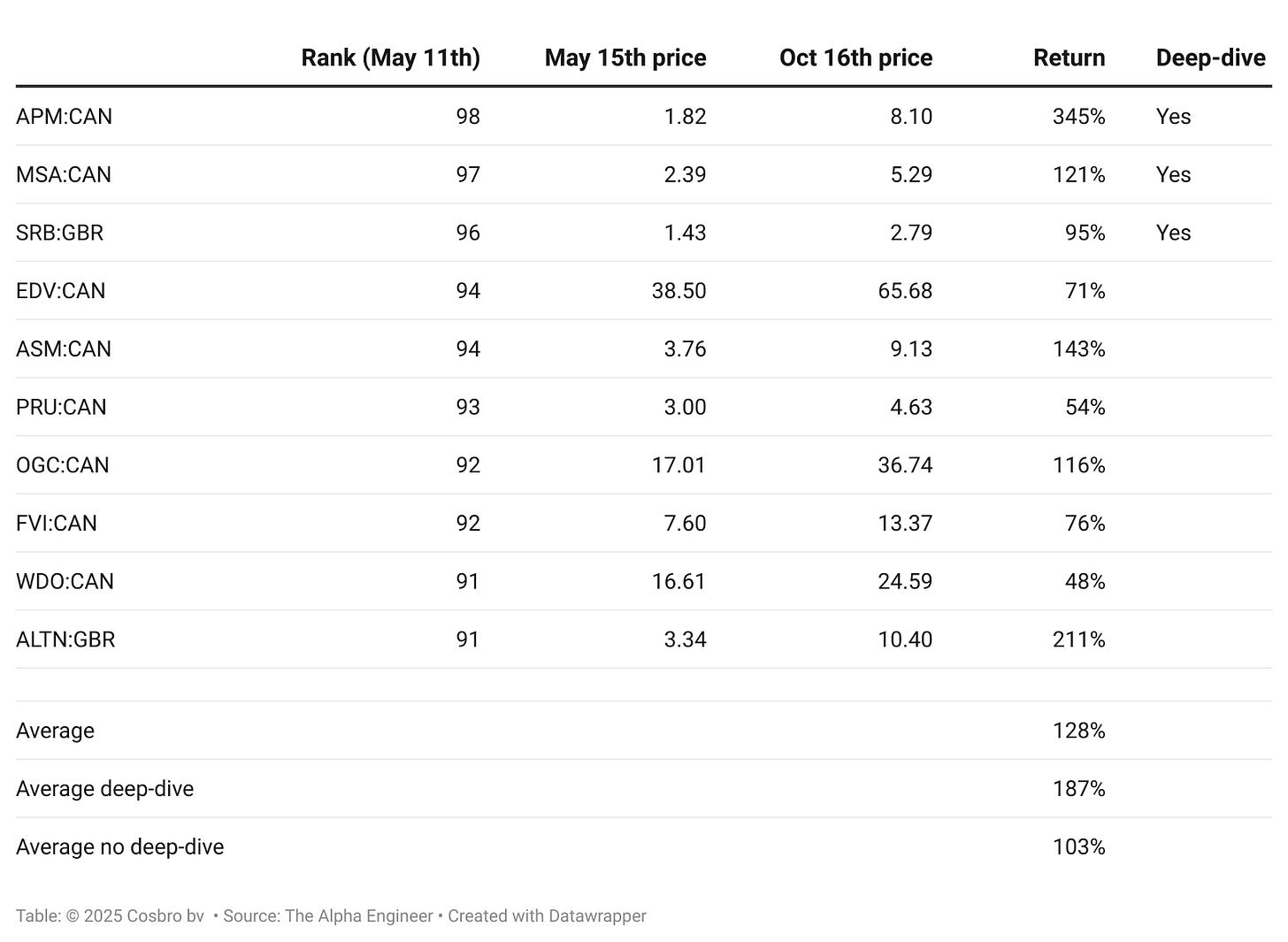Live Case Study - Ranking Silver & Gold Miners
10 stocks - 10 winners - from 48% to 345% gains in 5 months
Five months ago, I published a systematic ranking of precious metal mining stocks and shared deep-dive analyses on the top three picks with paid subscribers. Today, I’m opening those analyses to everyone—because the results speak for themselves.
The outcome: All ten stocks gained between 48% and 345%. The three top-ranked stocks I analyzed in depth? They returned +345%, +121%, and +95%—averaging 187% compared to 103% for the other seven stocks.
This isn’t a backtest. These are real-time results: the ranking found the opportunities, and the deep-dive research confirmed ones that had multibagger potential.
The Results: A Clean Sweep
Every single stock on this list delivered positive returns. The average gain across all ten holdings was 128% over five months—substantially outperforming broader market indices during the same period.
To put these returns in perspective: the VanEck Junior Gold Miners ETF (GDXJ), a representative benchmark for this sector, gained 87% during the same five-month period. The average return of my top 10 ranked stocks exceeded this benchmark by 41 percentage points. The deep-dive selection of the three highest-ranked stocks exceeded it by 100 percentage points.
More significantly, the ranking itself demonstrated predictive power. The three highest-ranked stocks (percentile ranks 98, 97, and 96) averaged 187% returns—nearly double the 103% average of the remaining seven stocks. The top-ranked stock delivered a 345% return. The system didn’t just identify a winning sector—it identified the best stocks within that sector.
What This Proves About Systematic Selection
This case study validates three critical principles:
1. Momentum-based ranking systems can identify sector rotations before they’re obvious.
In May 2025, my ranking system had identified multiple precious metal miners in the top percentiles. This wasn’t coincidental—the momentum factor in my model was detecting early signals of sector strength before it became consensus. Gold prices were rising, but not all miners were benefiting equally. The ranking concentrated on those showing the strongest combination of value, quality, and momentum characteristics. While the sector itself performed well (as evidenced by GDXJ’s 87% gain), my systematic approach identified which specific stocks within that sector offered superior opportunities.
2. Quantitative ranking systems can identify opportunities institutional investors overlook.
These weren’t mega-cap miners with billion-dollar market capitalizations. All three deep-dive selections were trading in the $150 - $500 million market cap range when identified. They operated in markets where limited analyst coverage and smaller float sizes created pricing inefficiencies. My systematic model, analyzing nearly 15,000 stocks globally, found them precisely because they met specific criteria: exceptional value metrics, strong quality indicators, and positive momentum signals.
3. High rankings correlate with superior performance when backed by fundamental analysis.
The ranking identified the universe. The deep-dive analysis confirmed why these stocks deserved their high rankings. While gaining momentum, they were still cheap compared to the run up in the industry. Andean Precious Metals traded at 2.3x forward EV/EBITDA while expanding production. Mineros traded at 4.8x P/E with a 6% dividend yield while generating substantial free cash flow. Serabi traded at 5.0x P/E while ramping production toward a doubling of output. The quantitative metrics reflected genuine business quality—not statistical noise.
4. Top-ranked stocks as a group significantly outperform the broader selection.
While individual stock performance varied, the statistical reality is undeniable: the three highest-ranked stocks returned 187% on average versus 103% for the other seven. This 84-percentage-point spread demonstrates that the ranking system doesn’t just identify winners—it identifies which winners offer the best risk-reward profiles. Even in a strong sector, position sizing toward the highest-ranked opportunities would have dramatically improved returns.
The Core Strategy: Trust the Ranking
Here’s what matters most: you didn’t need the deep-dive analyses to capture these returns. The ranking itself identified all ten stocks. Simply following the systematic methodology would have delivered a 128% average return over five months.
The Alpha Engineer methodology is built on a systematic, quantitative approach that hase the ranking at its core: My Method Explained.
The core process is straightforward:
Buy stocks from the top of the ranking
Hold them while they remain highly ranked
Sell when they drop below the ranking threshold (typically around rank 90)
Reinvest proceeds in the current top-ranked opportunities
This systematic approach has historically delivered 37% CAGR since 2010 and 42% return since late February 2025 (with each trade of the model portfolio documented and announced prior to the transaction for paid subscribers). This five-month case study demonstrates it working in real-time. The ranking identified the sector momentum. The ranking identified the specific stocks. The ranking separated the best performers from good performers.
No discretionary decisions. No emotional reactions. No need to time entries and exits based on market sentiment. The system continuously analyzes nearly 15,000 stocks and tells you which currently offer the best combinations of value, quality, and momentum.
The Dynamic Nature of the Ranking
The May snapshot represented one moment in time. The ranking system operates continuously, updating as new data emerges and market conditions shift.
This dynamic process continued identifying opportunities beyond the original ten stocks. For example, in July Golconda Gold (GG:CAN) moved to the top of the ranking as its metrics improved. My model portfolio added it, as did my personal portfolio. I mentioned it in a note to my followers and subscribers. The result? An additional 185% return for those following the systematic process.
This illustrates a critical advantage of systematic approaches over static stock picking: the ranking adapts as conditions change. New opportunities emerge. Some stocks maintain their rankings. Others drop out as fundamentals deteriorate or valuations expand. The quantitative model continuously identifies which stocks currently offer the best risk-reward characteristics across the entire universe of nearly 15,000 analyzed stocks.
The Deep-Dive Add-On
The deep-dive analyses represent an additional layer—the icing on the cake, not the cake itself.
I maintain a separate portfolio for deep-dive selections. These aren’t regular publications. I only publish deep-dive analyses when my research identifies stocks with convincing multibagger potential (100%+ returns) within a two-year timeframe. Why that threshold? With a systematic strategy delivering 36% annual returns, a deep-dive selection needs exceptional upside to justify concentrated position sizing outside the core methodology.
For these three precious metal miners, the deep-dive research identified specific characteristics that suggested multibagger potential:
Andean Precious Metals (APM:CAN) returned +345% since May 15th and +391% since the deep-dive on March 29th. The analysis highlighted the opportunities for its Bolivian silver mine and US gold mine. Read the full Andean deep-dive.
Mineros SA (MSA:CAN) returned +121%. The scenario analysis calculated probability-weighted returns of 83%, with specific catalysts including operating leverage to gold prices and M&A expansion opportunities. Read the full Mineros deep-dive.
Serabi Gold (SRB:GBR) returned +95%. The analysis calculated probability-weighted returns of 152% driven by the Coringa project ramp-up and production doubling trajectory. Read the full Serabi deep-dive.
These deep-dives provided conviction for concentrated positions. But the ranking system had already identified these stocks as exceptional opportunities. The deep-dives simply explained why in comprehensive detail.
What the Data Shows
This five-month case study demonstrates four distinct approaches to capturing sector opportunities, each with different risk-reward profiles:
Approach 1: Sector ETF Exposure
The simplest approach: buy a sector ETF when you believe it will outperform. GDXJ delivered +87% during this period—a strong result. The challenge: you need the sector insight upfront, and you get exposure to everything—the winners and the losers, the efficient operators and the struggling ones. Your returns will approximate the sector average.
Approach 2: Top-Ranked Sector Concentration
A more refined approach: when a sector becomes statistically overrepresented at the top of the ranking (indicating both attractive valuations and building momentum), concentrate in those top-ranked names. The May snapshot showed 10 precious metal miners ranked 90 or higher. Following this approach delivered +128% average returns—41 points above the sector benchmark. The ranking filtered out the underperformers and concentrated on stocks with the best quantitative characteristics.
Approach 3: Systematic Portfolio Method
The core Alpha Engineer methodology: maintain a diversified 50-stock portfolio by continuously buying stocks ranked 97-99 percentile across all sectors and selling when they drop below a threshold. No sector bets required—the ranking naturally allocates to sectors showing the best risk-reward characteristics. My model portfolio currently holds 6 precious metal miners (12% of portfolio) acquired over the past months. This is notable: precious metal miners typically represent only about 1% of the 15,000 stocks analyzed by the system. The ranking concentrated them to 12% of the portfolio—a 12x overweight that occurred organically as these stocks rose to the top of the rankings. Their average return: 144% over an average 4 months holding period (sofar), or approximately +180% extrapolated for 5 months. This approach captured the sector opportunity without requiring any upfront sector view—the systematic process identified it automatically and allocated accordingly.
Approach 4: Deep-Dive Enhanced Systematic Approach
The most sophisticated approach: follow the systematic method while conducting deep-dive analysis on the highest-ranked stocks to identify those with exceptional multibagger potential. Overweight these positions in a separate conviction portfolio. The three deep-dive selections averaged +187%—marginally outperforming the systematic approach alone.
Beating the System
Here’s what this comparison reveals: beating a systematic quant method is difficult. Even with extensive fundamental research, detailed scenario modeling, and probability-weighted return calculations, the deep-dive selections (187%) only marginally outperformed the model portfolio’s systematic approach (180% extrapolated). The quantitative ranking, applied consistently without discretionary judgment, captured nearly all the available alpha.
Does this mean deep-dive research adds no value? Not at all. The ability to identify and overweight the highest-conviction opportunities—like the 345% winner—can significantly enhance overall portfolio returns when done correctly. But the data demonstrates that the systematic method alone delivers exceptional results. The deep-dive layer is valuable enhancement, not a necessary requirement.
The ranking operates continuously, identifying the best opportunities across nearly 15,000 stocks regardless of sector. When precious metals showed favorable momentum and value characteristics, the system naturally allocated to them. When other sectors show better characteristics, the system reallocates. No predictions required. No sector timing needed. Just systematic execution of a quantitative process.
The ranking system continues operating, analyzing nearly 15,000 stocks across global markets. Some current top-ranked stocks are precious metal miners. Many are in completely different sectors. The model focuses on quantitative characteristics that historically correlate with superior returns, regardless of sector narratives.
Paid subscribers receive:
Weekly Stock Rankings --- Access to my proprietary ranking of approximately 3,700 stocks across the US, Europe, UK, and Canada, updated weekly
Buy/Sell Strategy --- Access to my method, porfolio manager tool and additional research
Model Portfolio --- Weekly transactions of the Alpha Engineer 50-stock model portfolio with performance tracking and insights in my own portfolio
Deep-Dive Analysis --- Regular, detailed research on potential multibagger stocks that have passed my quantitative and qualitative filters
Direct Access --- Get insights from someone who’s spent two decades testing and refining investment strategies with skin in the game
Free subscribers now have access to the three deep-dive analyses:
Learn more about my investing framework:
Read about my overall portfolio strategy.
See the full details of my systematic method for stock picking.
The Alpha Engineer --- Investing with a quantitative edge
Disclaimer: The Alpha Engineer shares insights from sources I believe are reliable, but I can’t guarantee their accuracy—data’s only as good as its inputs! This content (whether on Substack, via email newsletters, X, or elsewhere) is for informational and educational purposes only—it’s not personalized investment advice. I’m not a registered investment advisor, just an engineer crunching numbers for alpha. My opinions are my own and may shift without notice. Investing involves risks, including the chance of losing money. Past performance, whether from back-testing or historical data, does not guarantee future results—outcomes can vary. So, please consult your financial advisor to see if any strategy fits your situation. Full disclosure: I may own positions in the securities I mention, as I actively manage my own portfolio based on these strategies.




